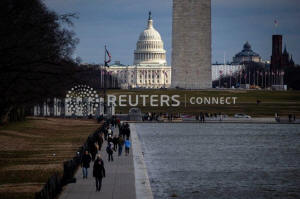|
U.S. government shutdown to crimp growth,
recession risk steady: Reuters poll
 Send a link to a friend
Send a link to a friend
 [January 24, 2019]
By Manjul Paul and Indradip Ghosh [January 24, 2019]
By Manjul Paul and Indradip Ghosh
BENGALURU (Reuters) - U.S. economic growth
will take a hit this quarter from the longest-ever government shutdown,
keeping the Federal Reserve on the sidelines until at least its April
30-May 1 meeting, a Reuters poll of economists showed.
But the probability of a U.S. recession in the next 12 months held
steady from last month at 20 percent, according to the median forecast,
while the chance of a recession in the next two years was also steady at
a median 40 percent.
The latest Reuters poll of over 100 economists taken Jan 16-23 also
showed a cut to the 2019 quarterly growth outlook, in line with a recent
run of weaker U.S. economic data pointing to rougher sledding for the
economy this year than last year.
"With the economy possibly easing and inflation not stirring in a
meaningful way, the case for additional tightening in monetary policy
seems weak," noted Michael Moran, chief economist at Daiwa Capital
Markets.
The partial government shutdown affecting 800,000 federal workers has
lasted more than a month and is expected to hurt the already-slowing
economy. The Senate is preparing for a vote on Thursday to fund the
government for three weeks.

Nearly 60 percent of about 50 economists who answered an additional
question said the shutdown will have a significant impact on first
quarter gross domestic product growth.
When asked how much of an impact the shutdown would have on U.S. GDP for
this quarter, the median was for a 0.3 percentage point trim. But
forecasts ranged between 0.1 and 1.3 percentage points.
Reuters Poll: Impact of US government shutdown on Q1 GDP - https://tmsnrt.rs/2AZ3LyZ
Analysts expected the U.S. economy to grow at a 2.1 percent annualized
pace this quarter, down from 2.3 percent forecast last month, followed
by 2.3 percent in the second quarter and then slowing to 1.9 percent by
the end of the year.
Growth forecasts were trimmed for each quarter this year.
"If the shutdown were to last for the entire quarter, it could subtract
around a full percentage point from Q1 inflation-adjusted output growth.
In a worst-case scenario, real GDP could indeed contract in Q1 if this
Congressional impasse remains unresolved," said Brett Ryan, senior U.S.
economist at Deutsche Bank.
"However, we have not made any changes to our current-quarter real GDP
growth forecast...given the uncertainty around these estimates."
[to top of second column]
|

People bundle up as they walk near the Washington Monument during a
partial government shutdown, in Washington, U.S., January 20, 2019.
REUTERS/Al Drago

A deep sell-off in financial markets last month drove several U.S.
stock indexes closer to bear market territory, and pushed
expectations for the Fed to slow the pace of its rate hikes. Fed
officials have also voiced growing concerns about the economy. Last
week, New York Fed President John Williams called for "prudence,
patience and good judgment" among policy makers.
The latest survey still predicted two rate hikes in 2019, in line
with the December poll and the Fed's own dot-plots. However,
economists now expect the Fed to take rates higher in the second
quarter instead of the first quarter, as predicted in the previous
poll.
But nearly one-third of 105 economists predicted the U.S. central
bank would either hike rates only once or keep the fed funds rate
unchanged at 2.25-2.50 percent in 2019. That was notably higher than
the 11 of 101 respondents in the previous poll.
Traders of U.S. short-term interest-rate futures expect no rate
hikes in 2019.
"We agree that the environment has shifted from that in December
when the Fed issued its latest dot plot and hinted at two additional
tightenings," noted Daiwa's Moran. "We have less confidence in our
projection of two hikes, but we will hold to that view at this
time."
The core PCE price index, the Fed's preferred inflation measure, was
expected to reach the Fed's target of 2 percent in the third quarter
and then forecast to level out to average slightly above that at 2.1
percent in the final quarter.
It was 1.9 percent in November.
Over 80 percent of 52 economists who answered a separate question
said a sell-off in financial markets and a sharper slowdown in the
U.S. economy pose the biggest challenges for the Fed in raising
rates this year.
"Global weakness, tightening financial conditions, and quiescent
inflation should lead the FOMC to pause their hiking cycle this
year. The timing of rate increases will depend crucially on incoming
data, but for now we expect the Fed to at least skip a Q1 hike,"
noted James Sweeney, chief economist at Credit Suisse.
(Polling by Sujith Pai and Manjul Paul; Analysis by Sujith Pai,
Nagamani Lingappa and Mumal Rathore; Editing by Ross Finley and
David Gregorio)
[© 2019 Thomson Reuters. All rights
reserved.]
Copyright 2019 Reuters. All rights reserved. This material may not be published,
broadcast, rewritten or redistributed.
Thompson Reuters is solely responsible for this content. |